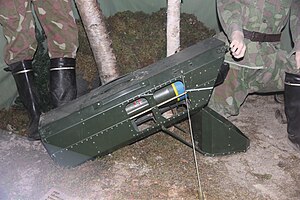Vickers Vigilant
| Vigilant | |
|---|---|

Vickers Vigilant
|
|
| Type | Wire-guided Anti-tank missile |
| Place of origin | UK |
| Service history | |
| In service | 1960s |
| Used by | United Kingdom, Finland, Kuwait, Dubai, Switzerland, United States of America |
| Wars | none |
| Production history | |
| Designed | 1956 |
| Manufacturer | Vickers-Armstrong (Aircraft) Ltd |
| Specifications | |
| Weight | 31 lb (14 kg) |
| Length | 3.5 ft (1.07 m) |
| Diameter | 0.12 m |
| Warhead | HEAT, 6 kg |
|
Detonation
mechanism |
impact |
|
|
|
| Engine | I.C.I. dual-thrust solid fuel rocket |
| Wingspan | 0.27 m |
|
Operational
range |
200 m to 1375 m |
| Flight ceiling | n/a |
| Speed | 348 mph (155.6 m/s) |
|
Guidance
system |
MCLOS wire-guided |
|
Steering
system |
control surfaces |
|
Launch
platform |
infantry or vehicle |
The Vickers Vigilant was a British 1960s era MCLOS wire guided anti-tank missile used by the British Army that was also licence-built in the USA for the US Marine Corps as Clevite.
Vigilant was a private development begun in 1956 by the Vickers-Armstrongs Guided Weapons Department at Brooklands, Surrey for the anti-tank role in the British Army, the name being formed from VIsually Guided Infantry Light ANti-Tank missile. Vigilant was wire-guided and optically tracked, like its successor Swingfire. As well as infantry use, it could be mounted on vehicles such as the Ferret armoured car and Land Rovers. Vigilant had a short service life: Swingfire started to replace Vigilant from 1966 onwards.
The missile system could be deployed in a number of configurations. The man-portable configuration consists of a launcher which doubles up as a transport container, a combined sight and controller, a battery and a 63 meter long cable. An optional Missile Selector Box allowed up to 6 missiles to be controlled by, and widely separated from, a single sight controller. The launcher box is placed on the ground facing the direction of expected targets, and then connected by the cable to the sight controller, which can be deployed some distance away. The sight controller is a pistol grip design, with two grips. The front grip has the launch trigger, and the rear grip has a thumb joystick for steering the missile. A low-magnification (3.2x) monocular forms the sight itself. Engraved stadia lines allow simple ranging, based on a typical tank target bridging the lines once in range.
The operator tracks the target using the sight mechanism, then launches the missile using the front trigger. Once the missile is in flight, he steers the missile into his line of sight using the thumb joystick. The missile's auto pilot uses a gyroscope to maintain a straight flightpath directly away from the launch point, compensating for any wind buffeting. When the operator moves the joystick, the missile applies a steering correction in the appropriate direction, once the joystick is released the opposite correction is applied automatically, keeping the missile travelling directly away from the launch point. Vigilant has a reputation for ease of control and high success with minimal operator training. This was largely due to the 'velocity control' method of Vigilant, relying on gyroscopes, rather than the simpler 'acceleration control' of competing missiles such as Entac or SS.11.
...
Wikipedia
